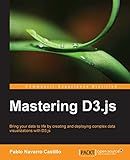Best D3.js Resources to Buy in December 2025

D3.js in Action, Third Edition



D3.js in Action: Data visualization with JavaScript



Interactive Data Visualization for the Web: An Introduction to Designing with D3



Developing a D3.js Edge



Mastering D3.js - Data Visualization for JavaScript Developers


To render object data in d3.js, you first need to create an SVG element in your document where the data will be displayed. Next, you need to bind the object data to DOM elements using the .data() method in d3.js. This method takes the object data as an argument and associates it with the selected elements.
After binding the data, you can use the .enter() method to create new SVG elements for each data object that does not have a corresponding DOM element. You can then specify how the data should be displayed by setting attributes such as x, y, width, height, fill, etc. Finally, you can update the display by calling the .exit() method to remove any extra elements and applying transitions or animations if desired.
What is the role of the .append() function in adding elements to object data in d3.js?
In d3.js, the .append() function is used to add new elements to the DOM (Document Object Model) based on the data provided. When used to add elements to an object in d3.js, the .append() function creates a new element of the specified type (e.g. , , , etc.) and appends it as a child of the selected element.
For example, if you have an object variable "svg" that represents an SVG element, you can use the .append() function to add new shapes or elements to the SVG. Here's an example of how the .append() function can be used to add a new circle element to the SVG:
var svg = d3.select("svg");
svg.append("circle") .attr("cx", 50) .attr("cy", 50) .attr("r", 20) .style("fill", "blue");
In this example, the .append("circle") function creates a new circle element and appends it to the SVG selected by the variable "svg". The subsequent .attr() and .style() functions are used to set the attributes and styling properties of the circle element.
Overall, the .append() function is a key method in d3.js for dynamically adding elements to objects based on data.
How to handle object data updates in d3.js using the merge() method?
To handle object data updates in d3.js using the merge() method, you can follow these steps:
- Select the elements that you want to update using the .selectAll() method.
- Bind the updated data to the selected elements using the .data() method.
- Use the .enter() method to append new elements for any new data that is added.
- Use the .exit() method to remove any elements that are no longer needed.
- Use the .merge() method to merge enter and update selections, so that you can apply shared attributes to both new and existing elements.
- Update the attributes of the merged selection to reflect the new data.
Here is an example code snippet that demonstrates how to handle object data updates in d3.js using the merge() method:
// Sample data var data = [ { name: "A", value: 10 }, { name: "B", value: 20 }, { name: "C", value: 30 } ];
// Create a selection and bind the data to it var selection = d3.select("svg") .selectAll("rect") .data(data, function(d) { return d.name; });
// Enter selection selection.enter() .append("rect") .attr("width", 20) .attr("fill", "blue");
// Exit selection selection.exit().remove();
// Merge selection selection.merge(selection) .attr("height", function(d) { return d.value; }) .attr("x", function(d, i) { return i * 30; }) .attr("y", function(d) { return 100 - d.value; });
In this example, we first select all the rect elements within an SVG element and bind the data to it. We then create enter and exit selections for any new or removed data. Finally, we merge the enter and update selections and update the attributes accordingly.
What is the purpose of the .enter() function in rendering new object data in d3.js?
The .enter() function in d3.js is used to create new elements based on the data provided. It is often used in conjunction with the .selectAll() function to perform data joins and render elements for each data item that does not already have a corresponding element in the selection.
When new data is bound to a selection using the .data() function, the .enter() function is called to create placeholders for any new data items that do not have corresponding DOM elements. The new elements are then appended to the selection and can be styled or positioned as needed.
Overall, the purpose of the .enter() function is to render new object data in d3.js by creating new elements for each data item that needs to be added to the selection.
How to use the data() method with object data in d3.js?
In d3.js, the data() method is used to bind data to elements in the DOM. When using the data() method with object data, you can pass in an array of objects and use key functions to specify how the data should be bound to the elements.
Here is an example of how to use the data() method with object data in d3.js:
- Create an array of objects with data you want to bind to elements:
var data = [ { name: 'Alice', age: 25 }, { name: 'Bob', age: 30 }, { name: 'Carol', age: 35 } ];
- Select the elements you want to bind the data to using d3.select():
var divs = d3.select('body').selectAll('div');
- Use the data() method to bind the data to the selected elements:
divs.data(data) .enter() .append('div') .text(function(d) { return d.name; });
In this example, we are binding the array of objects to the selected div elements. The enter() method is used to create new div elements for each object in the data array that does not have a corresponding DOM element. Finally, we use the text() method to set the text content of each div element to the 'name' property of the corresponding object in the data array.
This is just a basic example of how to use the data() method with object data in d3.js. There are many ways to customize how data is bound to elements using key functions and update methods.
